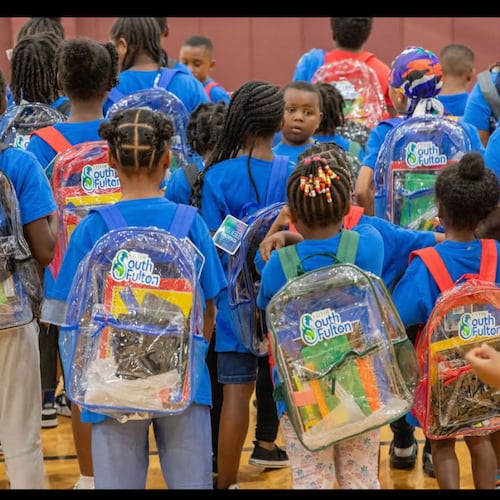Kennesaw State University math professor Babak Moazzez asked his calculus class a question about 15 minutes into his lecture Thursday morning.
“Good, Daniel,” the professor said after the student correctly typed his response.
A few minutes later, four students wrote answers to another question.
Until last week, Moazzez’s class met on campus, and students asked and answered questions face-to-face. Now, like all KSU courses, it’s being done remotely. Students log in to watch the professor teach. Moazzez writes formulas and text that appear in the middle of the screen. Students type answers to his questions that appear in the top right corner.
» COMPLETE COVERAGE: Coronavirus in Georgia
Georgia colleges and universities are holding classes remotely for the rest of the semester after closing their campuses earlier this month to prevent the spread of the coronavirus. Some schools have started such instruction, but most of the state’s largest institutions will begin next week.
The transition presents particular challenges for faculty teaching courses with extensive hands-on instruction or that require significant face time with students. Faculty and administrators said in interviews it’s not easy teaching classes on welding, calculus, fashion design or dance from a computer. Georgia State University has told its faculty that some assignments are no longer possible.
Other issues include finding software that more instructors can use simultaneously, that allows faculty to show students everything they’re trying to teach and that they can use for exams. The tools must also be usable for students with disabilities.
“There is not a one-size-fits-all solution,” KSU President Pamela Whitten wrote Tuesday on her blog. “Faculty members are tailoring their solutions for what makes sense for each unique course. This is not easy, nor is it perfect.”
KSU, which has about 35,000 students, is the largest Georgia school that has begun remote learning.
This shift is requiring professors to rethink how they teach students content typically done in labs, said Yakut Gazi, associate dean of Learning Systems for Georgia Tech’s global campus. There’s more theoretical discussion and more writing. About 350 faculty members and 65 student advisers went through training sessions this week, she said. Faculty, she said, must think more now about ensuring students have everything they need to learn as opposed to solely focusing on covering all the required content.
Brenau University senior Jordyn De La Rosa was skeptical about the plan to teach courses online.
“I honestly didn’t believe it. There’s no way they’re going to uproot us to online,” said De La Rosa, 21, who has returned to her family’s home in Monroe, about 50 miles east of downtown Atlanta.
Brenau began online instruction Monday. So far, De Le Rosa said, it’s gone well.
Students say in interviews and in online discussions some less tech-savvy instructors are having trouble sharing their lessons remotely. Many faculty members have never done this before. Some complain the remote learning is done in lectures much shorter than their classes.
Administrators and faculty are preaching patience as they work out the glitches. Moazzez’s face, for example, was not on the screen for much of the 100-minute class, but his voice could still clearly be heard. The professor said he faced other problems during test runs, such as not everyone could see what he was writing. Overall, Moazzez said the transition “has been great.”
Students can watch classes on their laptops, tablets or smartphones. Some classes are taught live. Others are posted online for students when they can watch.
Faculty are using software provided by their schools, primarily an app called “Blackboard Collaborate,” to teach the courses. Platforms such as Facebook Live won’t work, Gazi said, because it doesn’t properly help students form subgroups or private breakout sessions. She said there are also concerns that non-students can see who’s online and have access to their names, which violates federal student privacy laws.
In some cases, instructors teaching more hands-on courses will focus more on writing, officials said in interviews. Many of these courses already included digital coursework, which makes the transition easier, said Steve Ferguson, chief information officer for the Technical College System of Georgia.
The Technical College System is also working with the Georgia Department of Education to ensure dual enrollment students have no major issues taking classes remotely.
“I think faculty and students are going to think a little differently on this,” Ferguson said. “We’ll have a lot of new ways of doing things.”
Some students have their own sarcastic reactions to all of this. One included a social media post of streaming services Hulu, Netflix and Spotify with their prices.
“The University of Georgia $28,000/year,” someone posted.
De La Rosa, a fashion design major at Brenau, said one faculty member has talked about doing more projects than tests, concluding the remote learning is increasing student critical thinking skills.
There are adjustments in some of her fashion courses, which typically involve sewing or hem work. Her professor’s plan was to help students rent a sewing machine who did not have one, but they couldn’t do so because of liability issues.
There are other alterations. De La Rosa had a scheduling conflict with two classes that are being taught simultaneously online. One professor posted the class on a platform she could review later.
Such changes are a part of her new world, along with now doing her coursework at her family’s home.
“Just getting into that new routine,” she said. “So far, most of us are taking it well.”
What’s a tough class to take remotely? Dance
Dance, as the modern dance pioneer Ruth St. Denis famously said, is “communication between body and soul.”
So how is something so personal taught through a computer?
That is the challenge for Kennesaw State University assistant professor Andrea Knowlton, now that the university is teaching all of its classes remotely after its campuses closed to prevent the spread of the coronavirus. She recently embarked on her first lessons.
“It’s very physical,” Knowlton said of dance instruction in an interview, “so this is a very different experience.”
One of her students, Leah Prince, said the greatest hurdle thus far is “keeping myself accountable” without a group of classmates to see in person during the week.
“We are all encouraging each other to stay creative,” said Prince, 19, a first-year student majoring in dance. “Don’t let yourself wallow in not being in the studio.”
Knowlton also misses the in-person interaction.
“I do,” she said. “I really do.”
The class still meets Mondays and Wednesdays, but not live. Knowlton posts the content for students to watch. The students send assignments digitally. There’s more critical thinking and writing, she said. The students send her time lapse videos of their warmups and some of their routines.
Prince sent her professor a 12-minute video condensed into 20 seconds. Prince, in her family’s backyard, stretches and then kicks her legs to the sky. She bends one leg into the other and twirls around before moving her arms in circles. It looks frenetic in 20 seconds.
Prince said her neighbors watched her routine with curiosity.
“I’m just out there dancing, doing my homework.”
Remote learning has its benefits. Prince said the time lapse video allowed her better “to see what I’m actually doing.” One advantage of live distance learning, though, is students can ask questions and immediately get answers.
Knowlton has been impressed by her students’ flexibility, and their professionalism, during this abrupt transition.
Dancers, she observed, are problem solvers.
“This is right up our alley,” she said.
About the Author
Keep Reading
The Latest
Featured






